Table of Contents
Mechanics
1. Units of Measure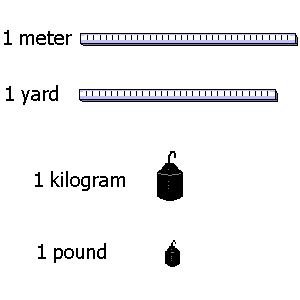 | A meter stick, yard stick, 1 kilogram mass and 1 pound weight are laid out on a demonstration table for inspection and comparison of relative size. |
(TOC)2. Time of Free-Fall
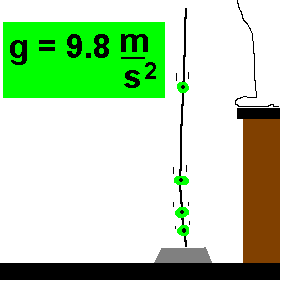 | A long string of metal washers is constructed such that the first one is 30 cm from the bottom end, the second is 130 cm from the bottom end, and the third is 2.74 m from the bottom end. When the string is released, the washers will sound out at constant time intervals.
(TOC) |
3. Force Vectors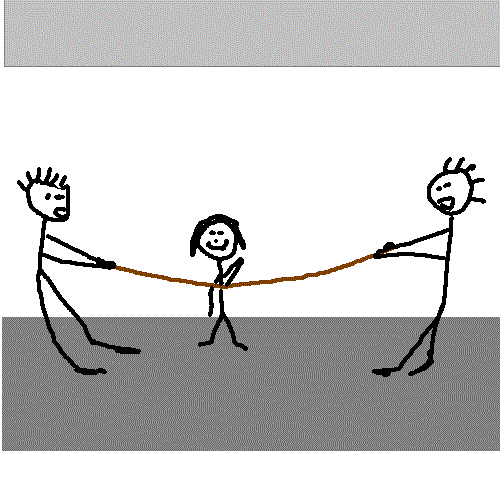 | Choose two of the largest students in the class to pull on the opposite ends of a strong 10 m long rope. Ask the students if the rope appears to be straight. Have the smallest student attempt to push down on the middle of the rope with one finger. The small student will easily be able to push the rope down.
Material: 10 m rope.
(TOC) |
(TOC)4. Force Vectors part 2
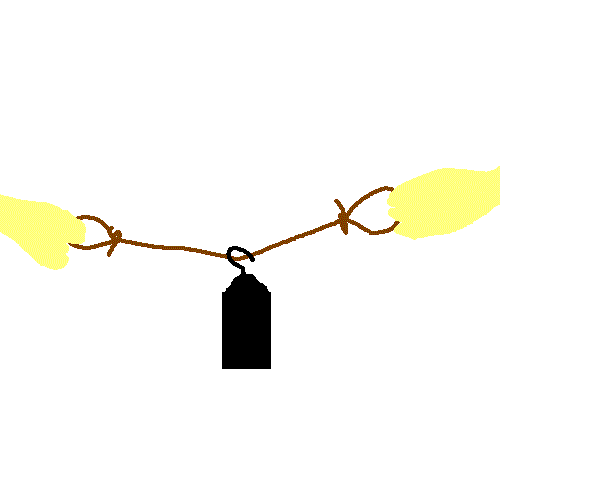 | To demonstrate the non-perpendicular components of vectors, tie two loops in the ends of a strong cord that is about 1 m long. Have a student hold a loop in each hand as a classmate carefully hangs a 1 kg mass on the cord. He/she should start with his/her hands together and slowly move them apart. It is not possible to keep the cord straight.
(TOC) |
(TOC)5. Vector Addition of Forces
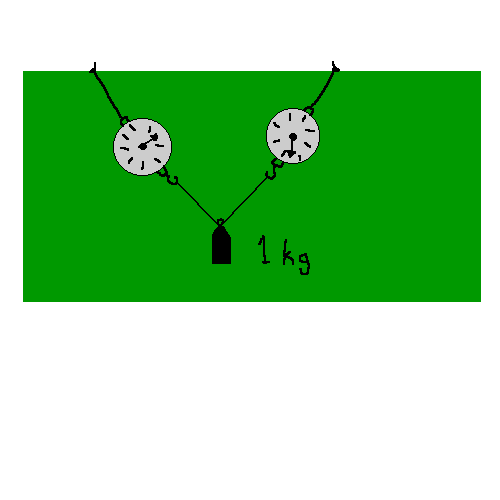 | To quantitatively demonstrate vector addition of forces, attach large dial type spring balances to the top of the chalkboard. Hang a known weight at various points on a string between them. The vectors then can easily be placed on the chalkboard and the equilibrium conditions worked out.
(TOC) |
(TOC)6. Hanging Block
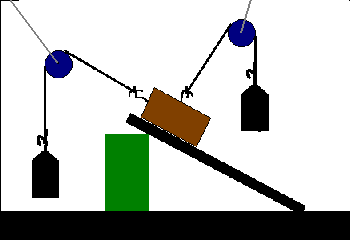 | To qualitatively demonstrate vector addition of forces, attach pulleys and string to a block of wood resting on an incline plane. Taking the "support" board away from the suspended block reveals a force vector equilibrium. The vectors then can easily be placed on the chalkboard and the equilibrium conditions worked out.
(TOC) |
(TOC)7. Inertia
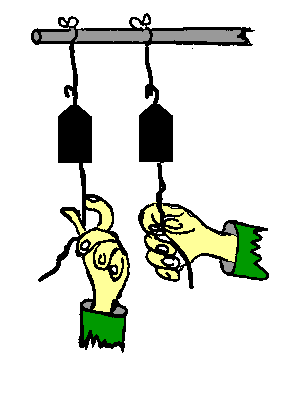 | Two identical weights are suspended by identical threads. Threads tied to the bottoms are pulled with different motions. The first is pulled with a slow pull-which causes the top thread to break. The second is pulled with a quick jerk-which causes the bottom thread to break.
(TOC) |
(TOC)8. Egg-Bounce
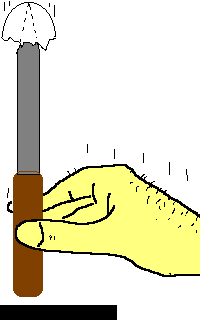 | Hold a kitchen knife with a sharp point vertically, and hang half an eggshell over the point. Challenge someone to puncture the shell by rapping the knife handle on a table or kitchen counter. Each time one tries the shell bounces off the tip of the knife unharmed. Hold the blade loosely in your hand. Make this appear as if you rap the handle on the counter when in fact you allow the knife to fall by its own weight so that it hits the counter and bounces. The imperceptible bounce sends the knife point through the shell.
(TOC) |
(TOC)9. Free-fall
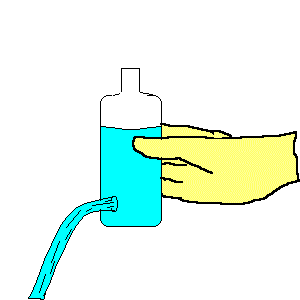 | Poke a hole in the bottom of a plastic water bottle. Fill the bottle 3/4 full of colored water. Drop the bottle into a container. While in freefall, the absence of pressure will stop the water from pouring out.
(TOC) |
(TOC)10. Vertical Acceleration NEW!!!
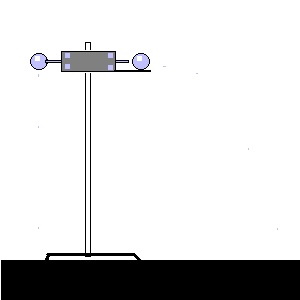 | Two metal spheres are simultaneously released by a spring-loaded device. One of the spheres drops vertically, the other is projected with horizontal speed. One can hear both hit the floor at the same time.
(TOC) |
(TOC)11. Central Acceleration -
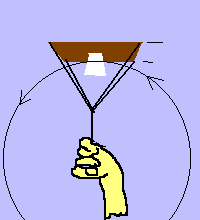 | A pail of water is whirled in a vertical circle without spilling the water when the central acceleration is greater than or equal to the gravity.
(TOC) |
(TOC)12. The Satellite
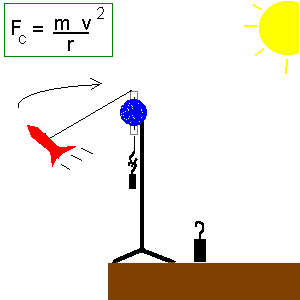 | A toy rocket is attached to a nylon line, which is threaded through a fire polished glass tube. The glass tube is mounted to the top of a ring stand. A hook is attached to the other end of the line for hanging various weights. When the rocket is tossed with tangential velocity, the resulting centripetal force assists in balancing the weight. The rocket will "orbit" many times before coming to rest on the "Earth". Questions to explore include: "What force keeps the hanging weight from immediately dropping to the ground?" "Where does the energy come from that keeps the rocket in orbit?" "How will hanging more weight to the hook affect the motion of the rocket?" - |
(TOC)13. Newton's Cradle I
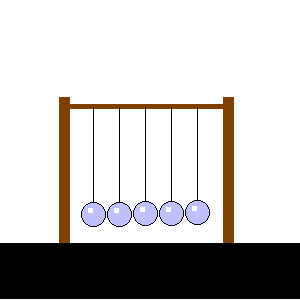 | The set of bifilarly suspended steel balls produce highly elastic collisions. Various combinations of balls can be dropped to illustrate conservation of momentum and energy.
(TOC) |
(TOC)14. Newton's Cradle II
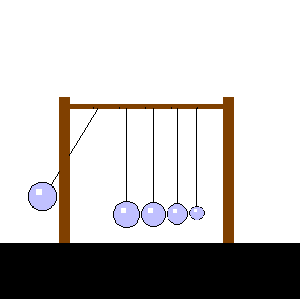 | A set of bifilarly suspended steel balls, of sequentially varying mass, dramaticly demonstrate the law of conservation of momentum and energy.
(TOC) |
(TOC)15. Skateboard Momentum
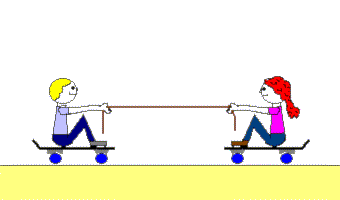 | Have two students sit facing each other on skateboards, approximately 3 m apart. Place a rope in their hands. Tell one to pull on their end of the rope. Ask the class which person is exerting more force. Both students will accelerate toward each other.
(TOC) |
(TOC)16.Action & Reaction - Water Rocket
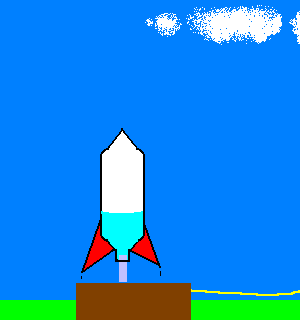 | The rocket is filled one third full of water and the remaining volume with compressed air. Velocities in excess of 30 m/s and heights of over 50 meters can be achieved.
(TOC) |
(TOC)17. Velocity of a Baseball
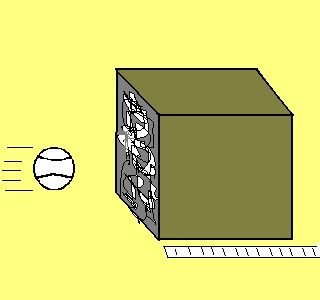 | A cardboard box is filled with crumpled newspaper so that a thrown baseball makes an inelastic collision with the box. By measuring the recoil distance it slides, the frictional force of sliding, and the mass of the box, the impact velocity can be calculated.
(TOC) |
(TOC)
18. Torque bar
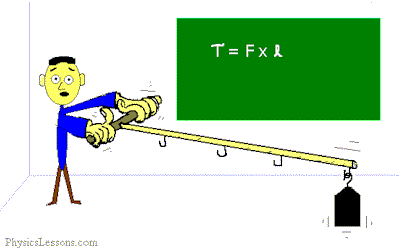 | A 1 kg weight can be placed at various distances from the axis of rotation. The student is challenged to bring the bar to a horizontal level.
(TOC) |
(TOC)19. Mechanical to Heat Energy NEW!!!
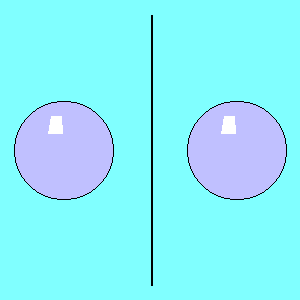 | Two 1-pound, 2-inch diameter, chrome steel spheres are smashed together with a piece of paper in between. After the collision, a charred hole that smells like smoke, remains in the paper.
(TOC) |
(TOC)
Copyright ©2000-2005
PhysicsLessons.com
If you have any suggestions, questions or comments email us!





















